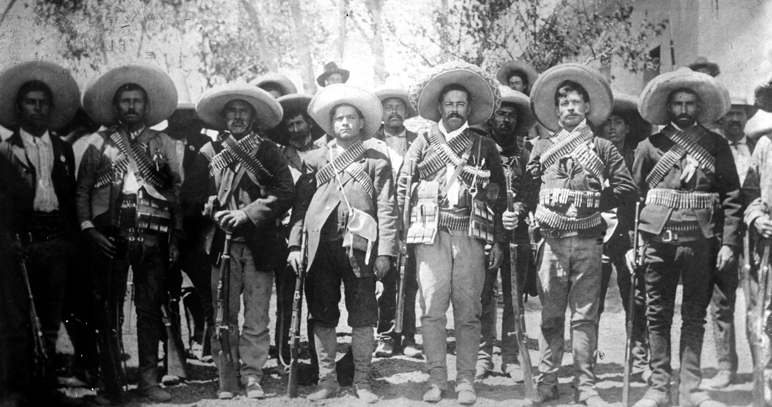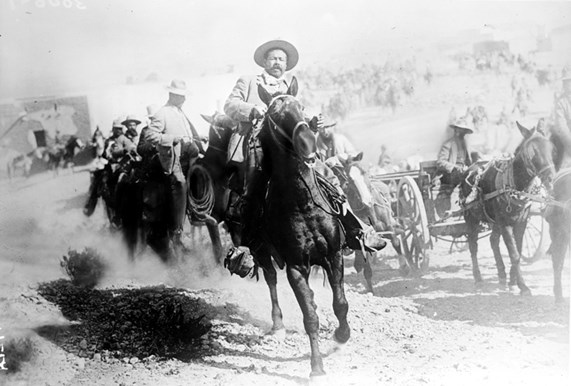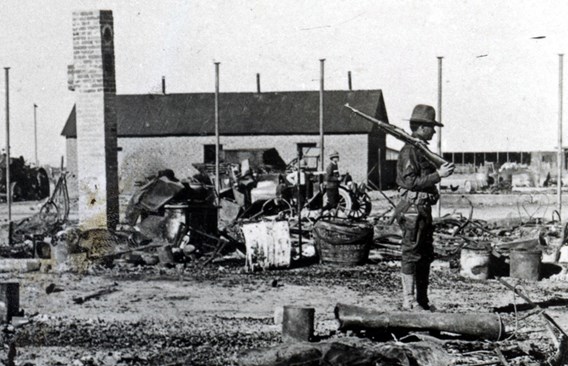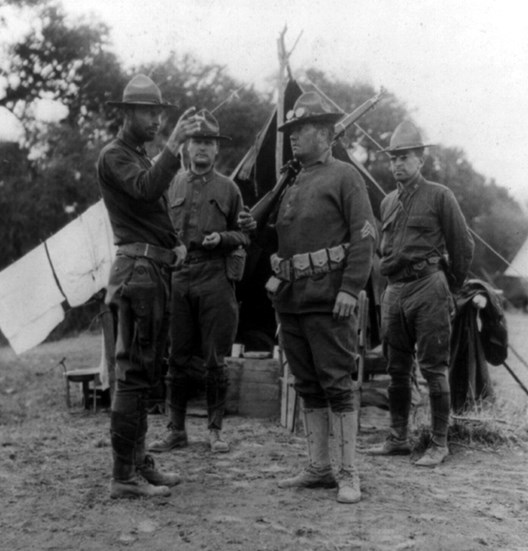
Trouble on the U.S.-Mexican border is not a new problem. A little more than a century ago, the violence of the Mexican Revolution spilled over into the United States with Pancho Villa’s deadly raid on Columbus, N.M.
General Francisco “Pancho” Villa was a revolutionary, terrorist and gunman. Pictured here he carries one of the ubiquitous Winchester rifles of the Mexican Revolution. Villa’s personal Model 1912 Bisley Colt revolver is not visible.
During 1915, U.S. President Woodrow Wilson proclaimed that Mexican Presidente Carranza had produced enough democratic reform in his government to gain the support of the White House, but revolutionary leader Pancho Villa turned violent against America in retribution.
In this photo of Villa and his lieutenants, most carry the Mexican Model 1910 Mauser carbine (7x57 mm Mauser), with a 17½” barrel. The 1910 carbines were handy arms for Villa’s horsemen.
The terrible warning signs began on Jan. 11, 1916, in Mexico’s Chihuahua province, at a train stopped in the town of Santa Ysabel. There, a group of Villa’s men, commanded by Col. Pablo Lopez, pulled 19 engineers of the American Smelting & Refining Co., all U.S. citizens, out of the passenger cars and shot them all. One man played dead and survived to tell the tale. The Mexican passengers corroborated his story. Deadly danger was poised to strike on the border.
Villa was an aggressive leader as well as one of Mexico’s greatest gunfighters. It has been written that the gun was more important to Villa than eating or sleeping—it was an essential part of his person.
By March 1916, Villa’s army was still reeling from a defeat in 1915 at the hands of the Mexican Federal troops at Celaya. Pancho’s “Division of the North” was in disarray, lacking funds and critical supplies. Villa’s troops wandered about in Northern Mexico, causing mayhem and looting the already dirt-poor inhabitants. From his base at Palomas, Villa planned a raid across the border. Nearby Columbus, N.M., was the target, with the tiny town situated just three miles north of Mexico. Columbus had a population of little more than 300 residents. The number of the town’s occupants had recently doubled due to Mexicans fleeing from the privations of Villa’s men.
Despite the fact they were a peasant army, their 7x57 mm Mauser and Winchester rifles gave Villa’s troops significant firepower for the era.
Villa’s spies crossed the border to scout the target, and seriously miscalculated the number of U.S. troops stationed at nearby Camp Columbus. They estimated only 30 American cavalrymen in the town, a number that represented less than a quarter of the members of the 13th Cavalry Regiment ready to defend the area.
A 13th Cavalry trooper, guarding the mean streets of tiny Columbus, N.M. in 1916.
In Villa’s camp, his men were reported to number 1,500. However, an American held hostage there claimed that only 600 had sufficient ammunition to be combat ready. With the battle lines drawn, the Villistas advanced in two columns in a twin-pronged attack. The time was 4:15 a.m. on March 9, 1916.
American townsfolk were awakened by the sounds of shooting, looting and the raging fires set to their homes. Villa’s terrorists shouted “Viva Villa” and “Viva Mexico” while they attacked an American community. Taken by surprise, the Americans quickly recovered. Townspeople fought back with their own handguns, rifles and shotguns.
Colonel Herbert J. Slocum was commander of the U.S. 13th Cavalry Regiment during Villa’s raid on Columbus, N.M.
Colonel Herbert Slocum, commander of the U.S. 13th Cavalry, had received reports during the day before about mobilization in Villa’s camp, as well as warnings that Columbus would be attacked. These reports had been dismissed as unreliable, and the American troopers were forbidden to cross the border to scout the situation for confirmation. Still, guards and patrols had been doubled, and this would ultimately pay dividends.
American troops used the Benét–Mercié Machine Rifle, Caliber .30, U.S. Model of 1909. Some trouble was experienced by troops lacking experience with the M1909 during the Columbus raid. Afterwards, newspaper articles mocked the M1909 as a "daylight gun" due to some jamming caused by feed strips accidentally inserted upside down in the dark. Additional training allowed U.S. troops to use the M1909 effectively during the ensuing Mexican Punitive Expedition.
The Benét–Mercié Machine Rifle used a 30-round feed strip of .30-cal. The rate of fire topped out at 600 rounds per minute. 
This U.S. trooper in the cactus poses with his M1903 Springfield rifle, the finest long-arm in action on the border.
Second Lieutenant John Lucas, commanding the 13th Cavalry’s machine gun section, responded quickly and set up a defensive position, leveraging his unit’s M1909 Benét–Mercié light machine guns. In the 90-minute firefight that followed, the troopers’ four Benét–Mercié machine guns fired in excess of 20,000 rounds. More than 30 other cavalry troopers joined in the fight, adding the accurate fire of their M1903 Springfield rifles. Their targets were illuminated by the Mexicans’ muzzle flashes and the eerie light of the burning buildings of Columbus.
Major Frank Tompkins commanded the 3rd Squadron of the 13th Cavalry Regiment during Villa’s raid on Columbus, N.M. Tompkins led two cavalry troops in pursuit of Villa's retreating force 15 miles into Mexico, inflicting severe casualties on the raider’s rear guard without losing a man of his own. Tompkins later served with distinction during the Mexican Punitive Expedition and was awarded the Distinguished Service Cross.
After an hour-and-a-half, the Villistas had enough, and their bugler called retreat. Major Frank Tompkins, received permission from Colonel Slocum to take his 3rd Squadron in pursuit. Tompkins and his cavalrymen chased Villa’s bandits 15 miles deep into Mexico, tangling with Villa’s rear guard at least four times, and drawing more blood from the Mexicans. For his aggressive action in pursuit of Villa, Maj. Tompkins was awarded the Distinguished Service Medal, later upgraded to the Distinguished Service Cross.
Villa’s raiders weren’t ready for the 13th Cavalry’s battery of Benét–Mercié Machine Rifles. Despite the Americans’ relative inexperience with the light machine guns, their steady volume of fire helped turn the Mexican raiders away.
The raid proved disastrous for Villa. As many as 170 of his troops were killed in the raid and the subsequent pursuit into Mexico. He left 63 dead on the battlefield in Columbus, and six were captured. One of the Mexican prisoners was given life in prison. The rest were hanged by the end of June 1916.
Troopers of the 13th Cavalry survey the killing fields outside Columbus on the morning after the battle.
There was no respect afforded the dead Villistas left behind at Columbus, their bodies, along with corpses of any Mexican horses, were dragged into a pile and burned.
Standing guard among some of the ruined buildings of Columbus, N.M. after Villa’s raid on March 9, 1916.
Columbus, N.M., locals look over the body of one of Villa’s raiders during the morning after the battle. The residents of the little town gave as good as they got during the raid, validating the necessity of the Second Amendment yet again.
There is some historical uncertainty about American losses in the battle. Generally accepted figures are eight dead among the Cavalry troopers, with an additional eight wounded. As many as 15 American civilians were killed. The nation, and President Wilson were outraged. The response from Washington was swift and strong. The day after the battle, President Wilson released this statement to the press:
“An adequate force will be sent at once in pursuit of Villa with the single object of capturing him and putting a stop to his forays. This can and will be done in entirely friendly aid to the constituted authorities in Mexico and with scrupulous respect for the sovereignty of that Republic.”
General John J. “Black Jack” Pershing was placed in command of a provisional division to track down and either capture or kill Pancho Villa. Beginning on March 15, 1916, nearly 7,000 American troops of the Mexican Punitive Expedition had crossed into Mexico to bring Villa and his men to justice.
By February 1917, Villa remained at large, despite several skirmishes between the expedition and the Villistas, as well as some fighting with Carranza government “Federales.” Pershing’s troops had penetrated more than 500 miles into Mexico, won several engagements, and took the United States and Mexico to the brink of outright war. American intervention in the Great War loomed, and President Wilson agreed to withdraw Pershing and his troops.
Long before there was a Department of Homeland Security, these American soldiers secured the border in New Mexico during 1916. Note they are armed with the M1903 Springfield rifle and the officer with the holster is carrying an M1911 .45 ACP pistol.
Homeland Security 1916: American troops search border crossers for arms.
By the end of August 1916, more than 100,000 U.S. troops were stationed along the Mexican border (most of these men were from National Guard units called up from around the country). Tensions remained high as America prepared for war with Germany, and newspapers were ripe with rumors about a German-Mexican alliance. Cooler heads prevailed, and war with Mexico was averted.
Pancho Villa was neither captured nor killed by the Punitive Expedition. But Pershing and his troops had made Uncle Sam’s point, retribution for the Columbus raid was extracted in blood, and Villa would never again violate the American border.
Additional Reading:
1916: Guns On The Border




































